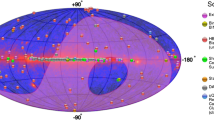Abstract
The satellite borne Pamela instrument is dedicated to the precise and high statistics study of CR fluxes on a four decades energy range. Pamela experiment is the last step of the “Russian-Italian Mission” (RIM) program established in 1992 between several Italian and Russian institutes and with the participation of Sweden and Germany. Designed as a cosmic ray observatory at 1 AU, it extensive program is made possible thanks to the outstanding performance of the instrument, the low energy threshold, the quasi-polar orbit and the 10 years duration of the observation. The physics program pays particular attention to the study of particles and antiparticles fluxes and includes search for dark matter, primordial antimatter, new matter in the Universe, study of cosmic-ray propagation, solar physics and solar modulation, and terrestrial magnetosphere. Very important is the discovery of the anomalous increase of the positron flux at energies higher that 50 GeV (the so called “Pamela anomaly”), and the abrupt spectral hardening of H and He, challenging the current paradigm of cosmic-ray acceleration and propagation in the Galaxy.
Similar content being viewed by others
References
NASA Cosmic Ray Program Working Group, “Cosmic Ray Program or the 1980’s”, NASA Report, August 1982. “The particle astrophysics program for 1985–1995”, NASA Report, October 1985.
M. A. Green, G. F. Smoot, R. L. Golden, et al., “Astromag: A superconducting particle astrophysics magnet facility for the space station”, IEEE Trans. Magnetics 23, 1240–1243 (1987).
R. L. Golden et al., “Wizard: A proposal to measure the cosmic rays including antiprotons, positrons, nuclei and to conduct a search for primordial antimatter”, College Eng., Ed. by NMSU (1988).
P. Spillantini et al., Il Nuovo Cimento B 103, 625 (1989).
E. A. Bogomolov, N. D. Lubyanaya, V. A. Romanov, et al., “A stratospheric magnetic spectrometer investigation of the singly charged component spectra and composition of the primary and secondary cosmic radiation”, ICRC (1979).
R. L. Golden, B. G. Mauger, S. Nunn, and S. Horan, “Energy dependence of the ratio in cosmic rays”, Astrophys. Lett. 24, 75–83 (1984).
P. Picozza, A. M. Galper, G. Castellini, et al., “PAMELA–A payload for antimatter matter exploration and light-nuclei astrophysics”, Astropart. Phys. 27, 296–315 (2007).
O. Adriani, G. C. Barbarino, G. A. Bazilevskaya, et al., “An anomalous positron abundance in cosmic rays with energies 1.5–100 GeV”, Nature 458, 607–609 (2009).
O. Adriani et al., “Cosmic-ray positron energy spectrum measured by PAMELA”, Phys. Rev. Lett. 111, 081102 (2013).
O. Adriani, G. C. Barbarino, G. A. Bazilevskaya, et al., “PAMELA Results on the cosmic-ray antiproton flux from 60 MeV to 180 GeV in kinetic energy”, Phys. Rev. Lett. 105, 121101 (2010).
O. Adriani, G. C. Barbarino, G. A. Bazilevskaya, et al., “Measurement of the flux of primary cosmic ray antiprotons with energies of 60 MeV to 350 GeV in the PAMELA experiment”, JETP Lett. 96, 621–627 (2013).
A. G. Mayorov, A. M. Galper, O. Adriani, et al., “Upper limit on the antihelium flux in primary cosmic rays”, JETP Lett. 93, 628–631 (2011).
O. Adriani et al., “PAMELA measurements of cosmicray proton and helium spectra”, Science 332, 69–72 (2011).
O. Adriani, G. C. Barbarino, G. A. Bazilevskaya, et al., “Measurements of cosmic-ray proton and helium spectra with the PAMELA calorimeter”, Adv. Space Res. 51, 219–226 (2013).
A. V. Karelin, O. Adriani, G. C. Barbarino, G. A. Bazilevskaya, et al., “New measurements of the energy spectra of high-energy cosmic-ray protons and helium nuclei with the calorimeter in the PAMELA experiment”, J. Exp. Theor. Phys. 119, 448–452 (2014).
M. Boezio, P. Carlson, T. Francke, et al., “The cosmicray electron flux measured by the PAMELA experiment between 1 and 625 GeV”, Phys. Rev. Lett. 106, 201101 (2011).
N. De Simone et al., Astrophys. Space Sci. Trans. 7, 425 (2011).
O. Adriani, G. C. Barbarino, G. A. Bazilevskaya, et al., “Time dependence of the proton flux measured by PAMELA during the July 2006–December 2009 solar minimum”, Astrophys. J. 765, 91 (2013).
V. V. Mikhailov, O. Adriani, G. A. Bazilevskaya, G. C. Barbarino, et al., “Spectra of primary cosmic-ray positrons and electrons in the PAMELA experiment”, Bull. Russ. Acad. Sci. Phys. 77, 1309–1311 (2013).
O. Adriani et al., “Measurement of the isotopic composition of hydrogen and helium nuclei in cosmic rays with the PAMELA experiment”, Astrophys. J. 770, 2 (2013).
O. Adriani et al., “Cosmic-ray positron energy spectrum measured by PAMELA”, Phys. Rev. Lett. 111, 081102 (2013).
V. Formato, O. Adriani, G. C. Barbarino, G. A. Bazilevskaya, et al., “Measurement of hydrogen and helium isotopes flux in galactic cosmic rays with the PAMELA experiment”, Nucl. Instrum. Meth. A 742, 273–275 (2014).
M. Boezio and E. Mocchiutti, “Chemical composition of galactic cosmic rays with space experiments”, Astroparticle Phys. 39, 95–108 (2012).
S. A. Koldobskiy, V. Formato, O. Adriani, G. C. Barbarino, G. A. Bazilevskaya, et al., “Measurement of galactic cosmic-ray deuteron spectrum in the PAMELA experiment”, Bull. Russ. Acad. Sci. Phys. 77, 606–608 (2013).
O. Adriani, G. C. Barbarino, G. A. Bazilevskaya, et al., “Measurement of boron and carbon fluxes in cosmic rays with the PAMELA experiment”, Astrophys. J. 791, 93 (2014).
O. Adriani, G. C. Barbarino, G. A. Bazilevskaya, et al., “Observations of the December 13 and 14, 2006, solar particle events in the 80 MeV/n–3 GeV/n range from space with PAMELA detector”, Astrophys. J. 742, 102 (2011).
G. A. Bazilevskaya, A. G. Mayorov, V. V. Malakhov, V. V. Mikhailov, et al., “Solar energetic particle events in 2006–2012 in the PAMELA experiment data”, J. Phys. Conf. Ser. 409, 012188 (2013).
O. Adriani, G. C. Barbarino, G. A. Bazilevskaya, et al., “The discovery of geomagnetically trapped cosmic ray antiprotons”, Astrophys. J. 737, L29 (2011).
Author information
Authors and Affiliations
Corresponding author
Additional information
on behalf of PAMELA collaboration
The article is published in the original.
Rights and permissions
About this article
Cite this article
Galper, A., Spillantini, P. Ten years of CR physics with PAMELA. Phys. Part. Nuclei 48, 710–719 (2017). https://doi.org/10.1134/S1063779617050185
Published:
Issue Date:
DOI: https://doi.org/10.1134/S1063779617050185




